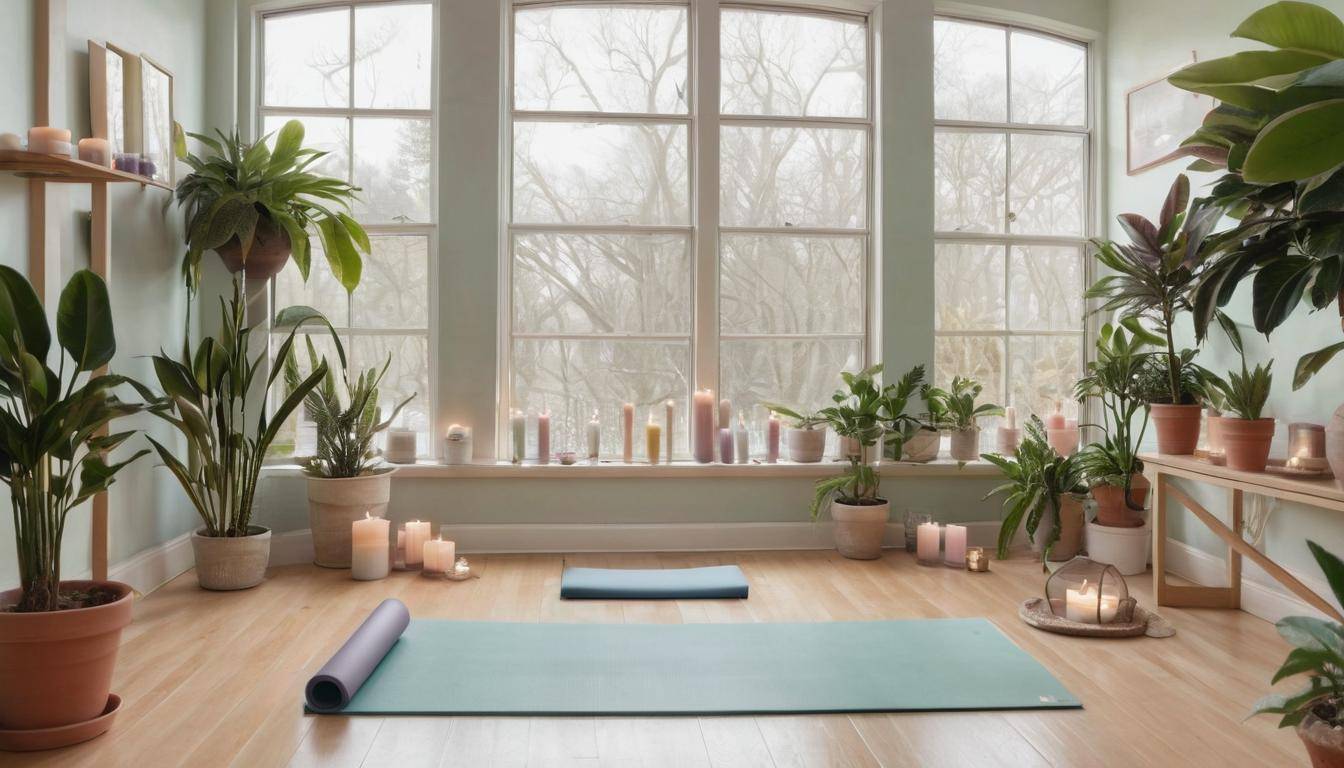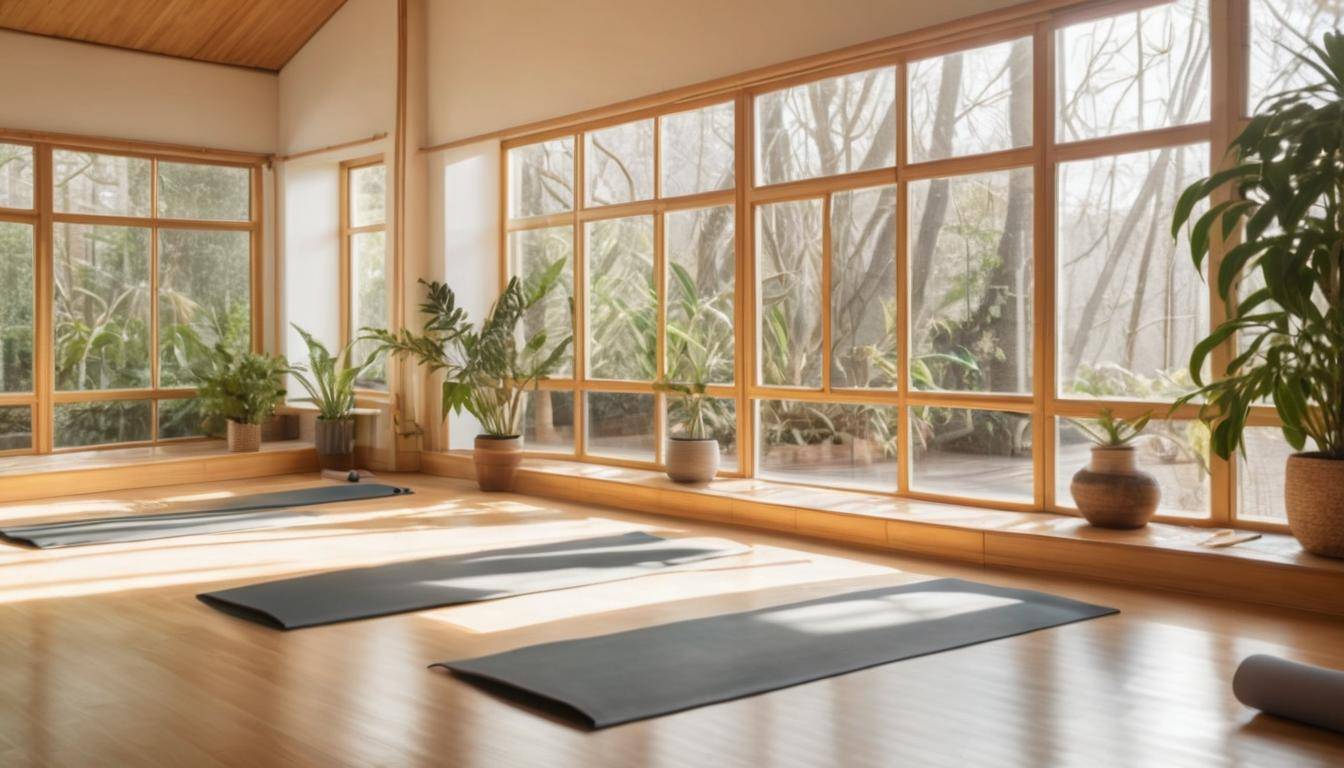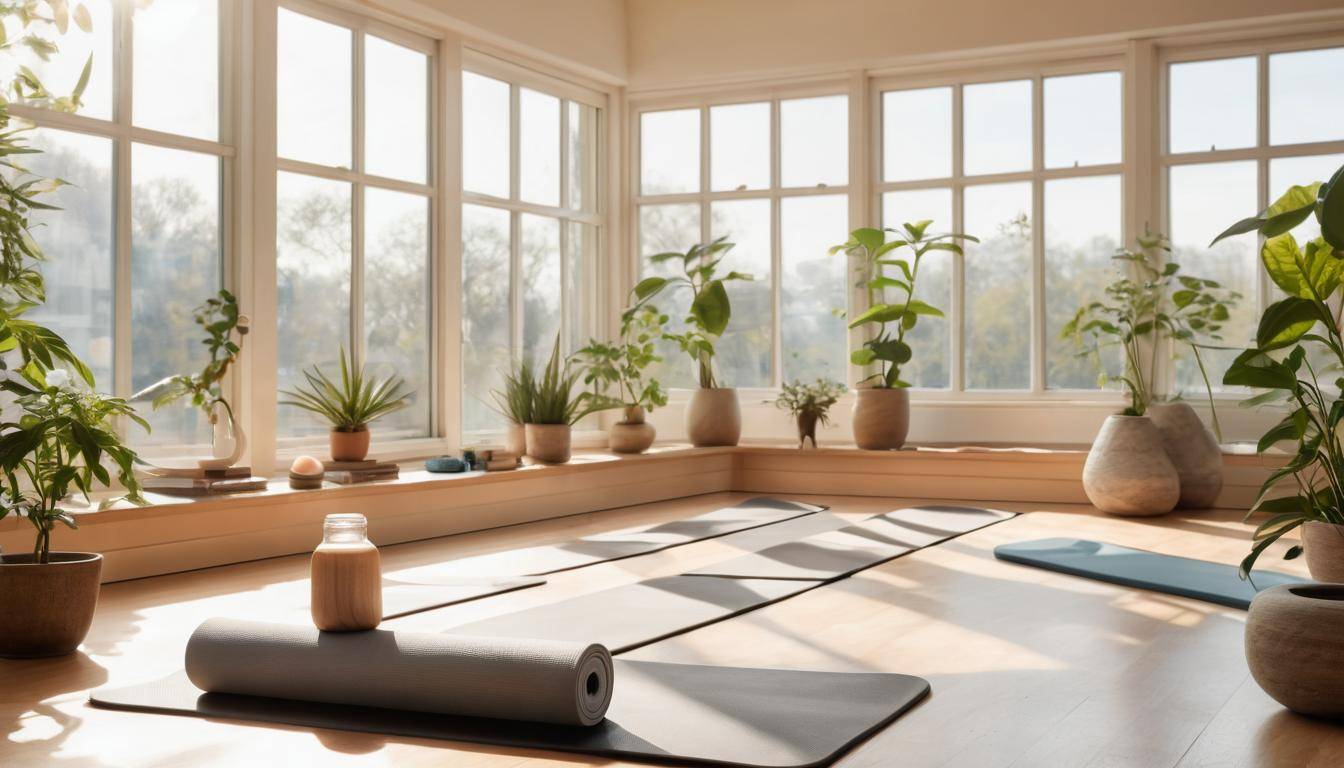In today’s high-paced life, finding ways to manage stress can feel overwhelming—especially when balancing work-life demands. Yoga offers more than just physical exercise; it bridges the body and mind to create harmony. By focusing on both breathwork and physical postures, yoga activates the body’s calming parasympathetic response, reducing stress hormones like cortisol and lifting your mood through elevated GABA levels.
Understanding these benefits makes it easier to see why incorporating yoga into your daily routine can be transformative. Take Child’s Pose: when sinking slowly into this gentle stretch, you might notice how tension melts away from your back and shoulders. The rhythmic flow of Cat-Cow gently eases spine discomfort while steadying your breathing—a mindful meditation in motion. And resting in Legs-Up-the-Wall Pose can bring unexpected tranquility as gravity supports your weightless legs, subtly easing different forms of fatigue. With such methods grounded in both ancient practice and modern science, we now turn our attention to specific poses that promise noticeable relief from everyday stressors.
Yoga promotes the mind-body connection by integrating physical postures, breath control, and meditation, which together enhance relaxation and reduce stress levels. This holistic approach encourages practitioners to be present in the moment, fostering mindfulness that helps manage anxiety and improve overall mental well-being.

Yoga and the Mind-Body Connection
At its core, yoga is a beautiful dance between movement and awareness. When you step onto your mat, you engage not only your muscles but also your mind. This practice encourages you to pay close attention to your breath, body sensations, and thoughts as they flow together in harmony. The synergy of physical postures (asanas) and controlled breathing techniques (pranayama) creates an environment where you can become more attuned to how your body responds to stressors. It’s a relationship where each component enhances the other, paving the way for profound relaxation and emotional stability.
Slow, deep breaths during yoga trigger the parasympathetic nervous system. This part of your autonomic nervous system promotes the “rest and digest” response, effectively counteracting the stress-induced fight-or-flight response and signaling your body to relax.
The Spiritual Harmony
Engaging in yoga not only calms the body but also invites introspection. As you navigate through poses, you often confront both physical limitations and mental barriers. This conscious confrontation nurtures self-acceptance and opens pathways to emotional resilience. The repetitive nature of asanas paired with mindful breathing fosters a meditative state that grants you insight into your inner landscape—helpful tools when facing day-to-day stressors.
As we explore this practice further, it’s essential to understand that each pose can cultivate a specific emotional state or physical benefit. For instance, forward bends are known for their calming effects on the nervous system while heart-opening poses can stimulate feelings of joy and gratitude. By realizing this connection, you can tailor your practice according to what fits your needs best at any given moment.
With this solid understanding of how yoga intertwines with well-being, we now turn our attention to some effective techniques that enhance stress relief through specific yoga practices.
Effective Yoga Poses for Stress Relief
One of the most accessible and calming yoga postures is Child’s Pose (Balasana). This gentle forward fold allows you to sink into a comforting embrace of your own body. As you stretch your arms forward and lower your torso towards the mat, you release tension from your back and create a safe space for introspection and relaxation. Children often adopt this pose naturally, reflecting its innate ability to restore tranquility. Practicing Child’s Pose encourages deep breathing, which can calm the nervous system and provide relief after a long day.
Building upon the serene qualities of Child’s Pose, let’s introduce another fluid movement:
The Cat-Cow Pose (Marjaryasana-Bitilasana) sequence enlivens the spine while promoting breath awareness. As you flow between arching your back in Cat Pose and dropping the belly in Cow Pose, you relieve spinal tension and stimulate energy flow throughout the body. This rhythmic movement enhances respiratory capacity, leading to an immediate feeling of relaxation. Engaging with this sequence regularly helps cultivate mindfulness as you synchronize your breath with these movements.
Continuing our journey through effective poses, we can’t overlook the transformative power of inverted positions.
Legs-Up-the-Wall Pose (Viparita Karani) involves lying on your back with legs elevated against a wall. This simple yet profound posture promotes lymphatic drainage, reduces swelling in the legs, and aids in gently lowering blood pressure. With your legs raised, gravity facilitates blood circulation towards your heart while allowing relaxed breathing patterns. In this posture, many beginners experience a refreshing change in perception—time feels suspended as anxiety lifts away, making it ideal during hectic days.
Incorporating these classic postures into your daily routine can yield substantial dividends over time. Each practice reinforces the mind-body connection, fostering resilience against stressors that may arise throughout life.
Now, as we explore further, let’s shift our focus to the essential role of breath in enhancing relaxation and well-being.
Breathing Techniques for Relaxation
Pranayama, often regarded as the yoga of breath control, serves as a powerful tool in our arsenal against stress. By focusing on various breathing techniques, we can tap into the calming potential of our breath, allowing us to regain a sense of equilibrium amid life’s chaos. Among these techniques, diaphragmatic breathing stands out as a simple yet effective method to initiate this calming process.
Diaphragmatic Breathing
Sometimes referred to as belly breathing, this technique engages the diaphragm, which encourages deeper breaths that increase oxygen intake. When we breathe deeply, we stimulate our vagus nerve, activating the body’s relaxation response. This cascade of physiological changes works wonders for anxiety levels; it slows the heart rate, reduces blood pressure, and signals the body to move away from a state of stress.
As you practice diaphragmatic breathing, try to focus your attention solely on your breath. Feel your abdomen rise and fall as you inhale deeply through your nose and exhale slowly through your mouth. Aim for five to ten minutes each day.
While diaphragmatic breathing offers a solid foundation for relaxation, another technique worth exploring is nadi shodhana, or alternate nostril breathing.
Nadi Shodhana (Alternate Nostril Breathing)
This ancient technique facilitates a balance between the left and right hemispheres of the brain by alternately closing each nostril. Imagine sitting quietly in a serene space while gently closing your right nostril with your thumb and inhaling through your left one. Then switch sides; close your left nostril and exhale through your right. The rhythmic nature of this practice fosters tranquility and mental clarity—a perfect antidote for busy minds caught in the whirlwind of daily life.
Many practitioners find that even just a few rounds of nadi shodhana have an immediate calming effect on their thoughts and emotions. To deepen this experience, it’s advisable to practice consistently; just ten minutes daily can deliver significant benefits over time.
Integrating such methods into your routine supports stress management and creates a more profound sense of well-being that resonates throughout one’s day.
Continued practice of these breathing techniques creates a natural path toward mindfulness exercises that enhance calmness and focus throughout daily life.
Meditation Practices for Calmness
At the heart of meditation lies the intrinsic ability to shape our thoughts and feelings. Mindfulness meditation, for instance, encourages individuals to pay attention to their surroundings while engaging in present-moment awareness without judgments. This focus on the now can have profound benefits; studies suggest that it significantly decreases stress hormones, enhancing emotional regulation.
Imagine sitting quietly, letting go of distracting thoughts, and consciously noticing your breath—each inhale and exhale connecting you back to yourself. In this state of mindfulness, stress starts to fade as you acknowledge emotions without getting entangled in them.
Mindfulness Meditation
Engaging with mindfulness isn’t just about deep breathing; it’s a continuous practice. When you dedicate a few minutes daily to simply observe your thoughts as they arise, you cultivate an attitude of curiosity rather than reactivity. This means when facing stressors, individuals who practice mindfulness are more likely to respond with calm rather than frustration.
With consistent practice, this response transcends your meditation sessions, seamlessly integrating into daily life.
Understandably, it might be daunting at first—to sit still and simply be amidst life’s distractions. But each attempt at mindfulness builds mental resilience over time.
Guided Imagery
Another captivating technique is guided imagery, which invites individuals to visualize serene landscapes or calming scenes that evoke feelings of tranquility. Picture a peaceful beach where the gentle waves lap against the shore or a quiet forest enveloped by tall trees. By immersing yourself in these vivid images during guided meditation sessions, you can effectively transport your mind away from the stressors of everyday life. Leveraging these visualizations not only calms the mind but physically reduces tension in the body too.
According to research from Johns Hopkins University, 30 minutes of meditation daily can reduce stress symptoms by an impressive 38%. This statistic alone underscores the importance of making time for such practices in our increasingly busy lives.
Integrating these meditation techniques into your routine provides not only immediate relief but also builds a foundation for long-term emotional health and well-being. As you explore these methods, consider the broader impact they may have on promoting overall mental wellness across various aspects of life.
Holistic Benefits on Mental Health

Engaging in yoga brings a wealth of holistic benefits that positively influence mental health. One significant aspect is how it improves mood. This can be attributed to the practice’s ability to elevate GABA (gamma-aminobutyric acid) levels in the brain. GABA is a neurotransmitter responsible for promoting feelings of calm and relaxation. As you go through your yoga routine, each breath and movement helps release endorphins, fostering an innate sense of happiness. Over time, practitioners report feeling more balanced and content.
As we move beyond mood enhancement, we find another invaluable benefit: the reduction of symptoms associated with depression.
Yoga offers an alternative route for individuals dealing with depression, providing a powerful antidepressant effect without the side effects that may accompany traditional medication. Research has shown that consistent yoga practice can lead to significant decreases in depressive symptoms. By incorporating physical postures, breath control, and mindfulness meditation, yoga nurtures both body and mind, paving the way for deeper emotional healing. Many find that this practice allows them to engage with their emotions in a safe space, leading to a heightened sense of well-being.
In addition to effects on mood and depression, another remarkable facet of yoga lies in its ability to enhance self-awareness.
Through regular practice, individuals naturally foster introspection, which serves as a critical tool for better managing emotions. Each session is an opportunity to tune into one’s body and mind, recognizing stressors and triggers that might otherwise go unnoticed. This heightened self-awareness empowers practitioners to make conscious choices in their lives—whether that’s recognizing when they’re becoming overwhelmed or understanding how certain situations affect their mental state. With this awareness comes an impressive skill set for emotional regulation that is invaluable in daily life.
Taken together, these holistic benefits highlight why integrating yoga into your routine can serve as a powerful ally for mental health.
These psychological transformations reinforce the essence of yoga as more than just physical exercise; it serves as a conduit for emotional healing and growth. Exploring this mind-body connection regularly through practice strengthens your mental foundation, preparing you to navigate life’s challenges effectively.
With these insights into yoga’s transformative effects in the realm of mental wellness, it’s important to consider personal stories that illustrate its impact further.
Real-Life Experiences and Tips

Testimonials from everyday practitioners often highlight the immediate and profound effects of yoga on their stress levels.
Take, for example, an office worker who shared how implementing a simple 15-minute yoga routine during lunch breaks dramatically shifted their entire day. They found that taking this brief moment to breathe and stretch not only calmed their mind but also provided renewed energy and focus for the tasks ahead. Such stories illustrate that yoga is not just an ancient practice; it’s a practical tool for managing the challenges of modern life.
Testimonials
As another practitioner noted, “Every morning, I dedicate ten minutes to yoga stretches and meditation. It sets a positive tone for the day and helps me navigate stressful situations with more ease.” These personal anecdotes resonate deeply because they emphasize the accessibility of yoga; even short sessions can have lasting impacts on mental well-being.
Tips from Practitioners
From these experiences, some key tips emerge that can enhance your own practice. The first is the principle of consistency. Even a brief daily routine builds momentum—think of it like watering a plant. A little water each day fosters growth, while sporadic attention can stunt progress. Consistency helps engrain the practice into your lifestyle, making it easier to turn to yoga in moments of stress.
Alongside consistency, personalized practices ensure that you remain engaged over time. Consider how combining your favorite poses with mindfulness techniques can create a practice uniquely suited to you. Personalization makes the experience enjoyable rather than a chore, which then fosters long-term commitment.
Quick Tip: For those seeking structured guidance, visiting Archie Foundation Home can offer tailored yoga sessions specifically designed for stress relief. Attempting new sessions or exploring specialized routines may inspire you further on your journey.
Ultimately, incorporating these insights into your routine—however small—can lead to significant changes in managing stress levels. By reflecting on real-life experiences alongside actionable tips, we see how yoga truly serves as an effective bridge connecting the mind and body in maintaining emotional balance amidst life’s demands.
In embracing these techniques and experiences, individuals can find their path toward improved mental well-being through the practice of yoga.
